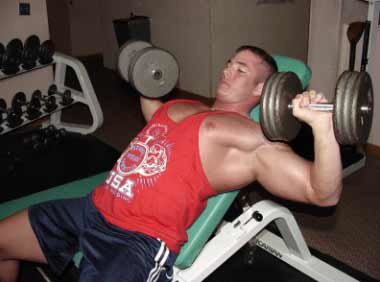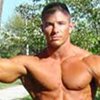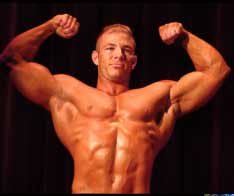The chest is perhaps the most widely sought after aspect of the human physique. It is the part that even the skinny-legged guys on the beach stick out. So why do so few people have a good one? Simple; they don't know how to work it properly. In this article I will outline two training programs and address the problem with the upper chest.
No true article about bodybuilding is complete without a description of the anatomy (at least in my opinion). So, let's get started.
The chest consists of two muscles: the pectoralis major and the pectoralis minor. You can also subdivide the pec major into the clavicular and sternal portions. The pectoralis minor originates at the coracoid process of the scapula and inserts into the third through fifth ribs. It's role is to adduct, or bring into the body, the arm. The clavicular portion of the pectoralis major begins at the body part of the clavicle and ends at the front of the upper arm. The sternal portion of the pectoralis major starts and the medial border of the sternum and shares the same insertion with the clavicular portion. Thus, this muscle serves to adduct, horizontally adduct, and internally rotate the arm.
TRAINING PROGRAMS
If you have previously read any of my articles you will know that I encourage rotating programs. The reasoning behind this rests in the fact that your muscles adapt very quickly to any form of resistance exercise (especially if you use enhancing drugs). Thus, to keep your body guessing and, in turn, growing you have to change things up. The first program I have outlined will be the first week's chest workout. The second program will be the second week's workout.
| Workout 1
Flat Bench Press: 12, 10, 8, 6 |
Workout 2
Incline Bench Press: 12, 10, 8, 6 |

The picture above illustrates the bottom position for incline dumbbell presses. The angle of the bench is too high but I was only doing this for the photo. For incline flyes you would turn your palms in towards your body to change the angle that your chest is working.
Substituting Exercises
 Not everyone will respond to the exercises I have written above. In that case it is you responsibility to try different exercises to properly stimulate your chest's growth. Below are a few examples.
Not everyone will respond to the exercises I have written above. In that case it is you responsibility to try different exercises to properly stimulate your chest's growth. Below are a few examples.
- Pec Deck
- Flat Cable Flyes
- Incline Cable Flyes
- Smith Machine Flat or Incline Press
- Parallel bar Dips @ 45° (this puts more emphasis on chest and limits triceps involvement)
- Push-Ups
*Note: On dumbbell fly movements keep your elbows flexed about 10-15° to keep from tearing your biceps. Also, bring your arms up in the same position like you are hugging a barrel.
If you try these substitute exercises and still are not feeling a good contraction try the following:
- Bring bar down to your chest
- Press up about 12-14 inches
- Hold for 1 count
- Return to chest without bouncing
- Repeat until it hurts
This is a good way to eliminate the use of triceps for chest movements. It will keep all the tension on your chest and will not give your muscles a chance to rest. Very good for heavy weights. If you don't believe me, watch "Pumping Iron" and pay attention to Lou's chest routine.

The Upper Chest Dilemma
How many times have you gone to the beach, the gym, or even a bodybuilding show and noticed that someone has no upper chest? I guess I just notice things, but it seems to be a common problem. Here is my reasoning behind this phenomenon: People just like to do flat bench. Incline bench is an exercise that most people have to decrease weight significantly simply because they have weak anterior deltoids and sub-quota upper pecs. To really attract the attention of the judges you have to have a well-proportioned body and that includes chest. The chest is brought into view on almost all front-facing poses. Here are a few.
As you can see from all these photos, the chest is very visible in any position. That is why it is key to fully develop your chest.
Thanks,


